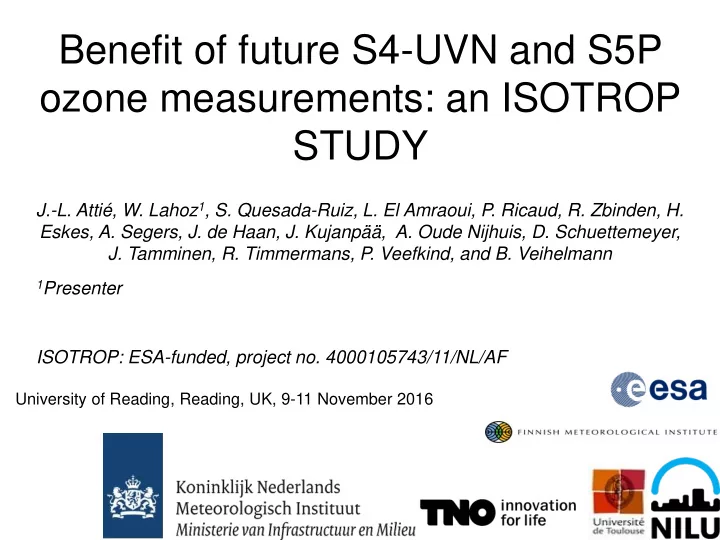

Benefit of future S4-UVN and S5P ozone measurements: an ISOTROP STUDY J.-L. Attié, W. Lahoz 1 , S. Quesada-Ruiz, L. El Amraoui, P. Ricaud, R. Zbinden, H. Eskes, A. Segers, J. de Haan, J. Kujanpää, A. Oude Nijhuis, D. Schuettemeyer, J. Tamminen, R. Timmermans, P. Veefkind, and B. Veihelmann 1 Presenter ISOTROP: ESA-funded, project no. 4000105743/11/NL/AF University of Reading, Reading, UK, 9-11 November 2016
Outline • Background • ISOTROP OSSE setup, including tests of the setup • Results – focus on ozone • Conclusions
Background ISOTROP: Impact of Spaceborne Observations on Tropospheric Composition Analysis and Forecast Objective: Quantify the benefit of the Sentinel 4, S4 (GEO) and Sentinel-5 Precursor, S5P (LEO) measurements of species such as ozone, CO, NO 2 , HCHO In particular vs ground-based observations and free model run Focus on ozone in this presentation Method: Use OSSE (observing system simulation experiment) approach to quantify benefit See Timmermans et al. (2015) for OSSEs concerning air quality measurements
OSSE Setup: Diagram of the OSSE components Cross-OSSE concept: TM5 and Lotos-Euros (LE) for Nature Run and use MOCAGE for DA Avoid identical twin problem: avoid over-optimistic results (Masutani et al., 2010)
List of assimilation runs PERIOD: SUMMER 2003 (JJA) MACC DOMAIN: 15W – 35E 35N – 70N
Calculation of the Obs. Cov. Matrix for S4 and S5P Calculation of the variance adapted to our DA system: σ 2 =(A t X NR -X r ) 2 A t : transformed AVK; X NR : NR profile; X r : ozone leading eigenvectors The Obs error cov matrix can be understood as : RHCOV = R_obs + R_rep Retrieval stores 6 leading eigenvectors: 4-6 tropospheric information + some stratospheric information – values should be approx 1
OmA and OmF This concerns the first 4 leading eigenvectors using R_obs (KNMI & initial approach) and R_HCOV (CNRM approach) LH: ev1, ev2, ev3 RH: ev4 Panel: left (R_obs), right (HCOV) OmA narrower than OmF for all 4 evs for HCOV Better representation of obs errors
Correlation using ROBS and RHCOV for June 2003 – 500 hPa HCOV FR vs NR S4 vs NR R=1 Histograms S4 vs NR HCOV has a better representation of observation errors
200 hPa Time-series of ozone for different pressure levels Impact of different ozone observations Free run: black 400 hPa GBS DA: red S5P+GBS: blue S5P+S4+GBS: green NR: grey 500 hPa The AR are closer to the NR than the FR at 500 hPa and 600 hPa 500 hPa: S5P+S4+GBS better 600 hPa 600 hPa: S5P+GBS (slightly better) 700 hPa: less impact from satellites; some impact from GBS 700 hPa
Diurnal variation at surface FR: black GBS: red S5P+S4: blue S4: green NR: grey No impact from S5P Higher values in red
Results: the metrics used Mean absolute error Root mean square error RMSERR(X)=1- 𝑆𝑁𝑇𝐹 𝐵𝑆 RMSE reduction rate or skill score 𝑆𝑁𝑇𝐹 𝑆𝑆 Correlation coefficient
Focus on ozone at 500 hPa and 700 hPa Summer 2003 (JJA) 500 hPa and 700 hPa likely the low altitude limits where S4 and S5P can add values to our system → No added value below 700 hPa → No clear added value at the surface
Ozone fields (ppbv) – summer 2003 (JJA) 700 hPa S4+S5P+GBS TM5 NR GBS S5P+GBS 500 hPa
MAE (%) – summer 2003 (JJA) 700 hPa Abs(S4+S5P+GBS – NR) Abs(GBS – NR) Mean abs bias vs NR Abs(S5P+GBS – NR) 500 hPa Some impact of S5P+S4 (not in S. Europe) Impact of S5P+S4
RMSE (ppbv) – summer 2003 (JJA) 700 hPa S4+S5P+GBS FR GBS S5P+GBS 500 hPa Some impact of S5P+S4 (not in S. Europe) Impact of S5P+S4
Corr Coeff – summer 2003 (JJA) vs NR 700 hPa S4+S5P+GBS GBS Histogram S5P+GBS 500 hPa Impact of S5P+S4
Skill score summer 2003 (JJA) - ref is GBS 700 hPa S4+S5P+GBS FR S5P+GBS 500 hPa S5P+S4 – impact vs FR Some impact from S4
Conclusions • Some changes clearly visible in ozone field at 700 and 500 hPa with a slight increase of ozone in the SE part of the domain - closer to the NR than the RR (GBS) • Main improvement is stabilization and decrease of bias (vs NR) over the period (Summer 2003 – JJA) of about 10 % at 700 hPa and 30% instead of 60% at 500 hPa. Impact is similar for S5P and S4+S5P with slightly better performance for the double assimilation (S4+S5P) • AR of S4 and S5P show more variability than the RR and the FR at 700 hPa whereas they show slightly less variability at 500 hPa - Except for S4+S5P assimilation where more variability is visible in the SE part of the domain comparable to the RR and FR • Improvement for both levels in the correlation (vs NR) when we add S4 or S5P. The histogram is slightly improved at 700 hPa whereas at 500 hPa it goes from 0.3 (GBS or RR) to 0.5 (S5P) and 0.5 (S4+S5P) • For both levels (700 hPa, 500 hPa), there is net improvement in the domain in terms of skill score with values closer to 1 for the double assimilation except in the SE of the domain • Benefit from S4 and S5P ozone at 500 hPa and 700 hPa – see MAGEAQ presentation
Recommend
More recommend